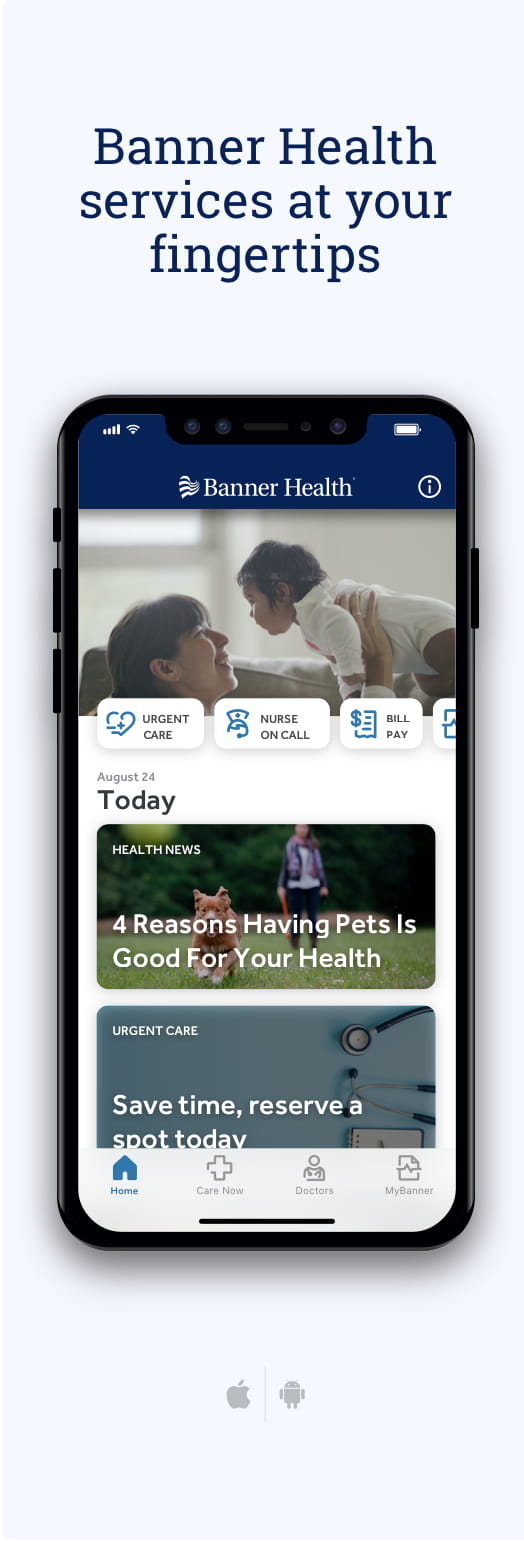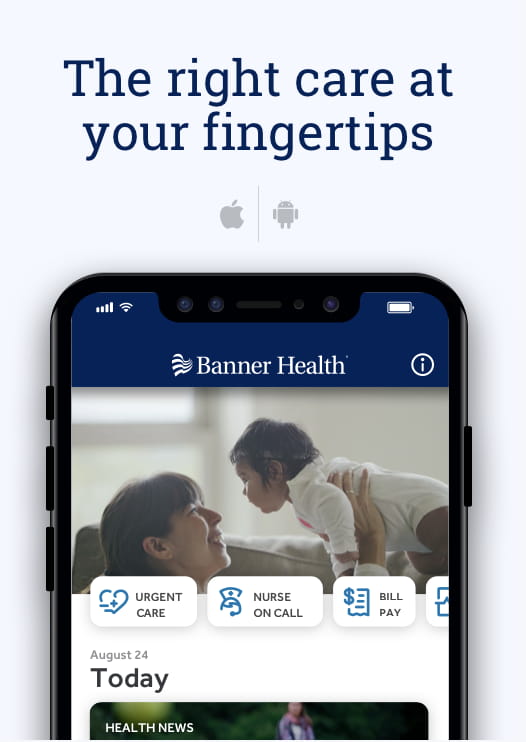You’ve probably watched friends and loved ones go through it. You’ve seen it referenced in movies and television. You’ve walked, run or worn colors or ribbons to support it.
Cancer treatment is something that touches everyone. But when you’re the one getting the diagnosis, any sense of familiarity seems to disappear.
If chemotherapy is part of your treatment plan, you may feel confused, overwhelmed and scared. However, Julie Lyon, RN, a patient education specialist with Banner MD Anderson Cancer Center at Banner Gateway Medical Center, pointed out that you’re never alone in your journey. You have many people — from doctors and nurses to patient navigators and social workers — by your side.
Here are a few things to know before your first treatment.
What is chemotherapy?
Chemotherapy, often simply called chemo, is a powerful cancer treatment that uses drugs to slow or stop the growth of cancer cells. The benefit of chemotherapy is that it can increase your odds of recovering from cancer.
Before chemotherapy starts, your health care team will put together a treatment schedule that’s targeted to your diagnosis and your overall health. Your plan will include the types of chemotherapy drugs you will take, how often you will need treatment, how long each treatment will last and any other therapies you might need.
Ask your health care team any questions you may have. Knowing what to expect can make you more comfortable with the treatment process.
Many treatment centers offer a chemotherapy class you can attend before your first treatment to learn more about what to expect, home medications, port care and safety measures. It’s a good idea to attend if it’s an option for you.
Your first day of chemotherapy
You may feel nervous or anxious about your first day of chemotherapy. Being prepared can help you feel more comfortable. Here's what to wear and bring with you to your treatment:
- Comfortable clothing in layers. “Many people feel cold during chemotherapy infusions,” Lyon said. If you have a port, wear a shirt with buttons so it’s easier to access.
- Identification and insurance information to make the check-in process go smoothly.
- Comfort items such as a cozy blanket or socks.
- Snacks and water. Chemotherapy sessions can take a long time, so you'll want some light, easy-to-digest snacks and a water bottle. “Snacks and drinks are usually available, but you may prefer to bring your own,” Lyon said.
- A tablet, e-reader, book or headphones so you can watch a movie or show, read or listen to music or podcasts to pass the time.
- A friend or family member if you would like to have someone by your side for support and companionship.
What the treatment process is like
When you arrive at the treatment center, you'll check in and the care team will take your vital signs and answer any questions you have. You’ll sit in a soft, comfortable chair — usually a recliner.
Next, they will administer your chemotherapy drugs. Depending on the type of chemotherapy, that could be an IV, medicine you take by mouth or injections. Your visit could be as short as one to two hours or as long as six hours. The team will watch you closely for any response to the treatment and will address your concerns.
After you finish your treatment, the team will observe you for a short time to make sure you don't have any reactions. It’s a good idea to have someone drive you home after your first chemo appointment. You may need to come in the next day for an injection, or two days later for a port pump discontinuation.
“Many times, chemotherapy is given in cycles so you can recover from one cycle’s effects before the next cycle starts,” Lyon said. A treatment cycle can include one or more days of chemo along with rest days.
Managing stress on treatment day
It's normal to feel anxious or stressed when you have chemotherapy treatments, especially the first time. These steps may help:
- Deep breathing exercises: Inhale slowly, hold your breath for a few seconds and exhale gradually. Repeat for several breaths.
- Mindfulness or meditation.
- Listening to calm music, watching a favorite TV show or reading: Entertaining yourself can shift your focus away from your anxiety.
- Telling your health care team how you're feeling: They can reassure you, answer questions and offer support.
Chemotherapy side effects
The strong medications in chemotherapy that get rid of the cancer can also cause some common side effects. “Not all people receiving chemotherapy experience all possible side effects,” Lyon said. “Most side effects of chemotherapy are short-term and can be handled with medicine and proper care.”
Here’s how to handle some of them:
- Nausea and vomiting: Medication and small frequent meals can help. Ginger and peppermint may also be good options. Carbonated beverages can settle your stomach. Avoid fatty foods, since they are hard to digest.
- Diarrhea: Eat bananas, white rice, applesauce and dry toast, and drink at least eight cups (64 fluid ounces or approximately two liters) of water daily. Talk to your provider before taking medication to treat diarrhea.
- Constipation: Add fiber to your diet and drink eight cups of fluids a day. Talk to your provider before using enemas or suppositories.
- Fatigue: You'll want to prioritize rest and conserve your energy. However, light activities such as short walks can help you feel better.
- Hair loss: You may want to look into wigs, scarves or hats if you feel self-conscious about your appearance without hair. “Ask your care team if scalp cooling to prevent hair loss might be an option for you,” Lyon said.
- Appetite changes: Focus on small meals with lots of nutrients and try different foods to see what you tolerate best. Drink liquids with a straw to minimize the taste.
- Weakened immune system: Practice good hygiene to reduce your risk of infection and let your health care team know right away if you have any signs of infection.
- Low blood counts: Ask for copies of your blood test results, since you could be at higher risk of infection if your white blood cell count is low.
- Chemo brain (problems with thinking): Stay organized by using day planners, calendars and checklists and use cell phone alarms and reminders to minimize forgetfulness.
Track your symptoms and side effects during chemo treatment. Note how strong they are and any patterns you notice. Share your experiences with your care team. They can use this information for treatment decisions.
Nutrition during chemotherapy
Since chemotherapy can cause nausea, vomiting and appetite changes, you’ll need to pay close attention to your food and fluid intake:
- Drink plenty of water, herbal tea and clear broth. Limit caffeine and alcohol.
- Choose a diet that includes fruits, vegetables, lean proteins and whole grains. You may want to talk to a dietician to come up with a meal plan that works for you during chemotherapy.
- Ask your health care team if you need any supplements. Some people need vitamin D or B12 during treatment.
- Keep healthy snacks on hand to help you maintain your energy.
Mental well-being during treatment
You'll want to prepare mentally and emotionally for chemotherapy. Take time to acknowledge and express your feelings. It can help to:
- Connect with friends, family, your health care team or support groups to share your feelings and experiences.
- See a therapist or counselor for additional emotional support.
- Try mindfulness meditation, yoga or relaxation techniques to alleviate stress.
- Make time for activities that bring joy and relaxation.
- Keep a journal — expressing your thoughts and emotions can give you a sense of control.
- Engage in creative activities like art, writing or music.
- Ask your care team about support services.
Lifestyle adjustments
Chemotherapy is different for everyone. You want to find the right mix of activities, rest, time with loved ones and self-care that works for you.
You may not be able to work on your treatment day and sometimes for the next few days. You may need help with things like shopping and preparing food. After your first couple of treatments, you’ll have a better idea of how they’re affecting you.
Listen to your body, pay attention to your energy levels and adjust what you do accordingly. Rest when you need to, even if you need to take a short nap during the day.
Create a routine that builds in enough time for rest. Breaking your tasks down into manageable segments can keep you from feeling overwhelmed. Ask friends and family for help so you can save your energy for the things you need to do.
Even if you're tired, gentle physical activity like walking or stretching can improve your energy levels. Talk to your health care team about the activities that might be best for you.
You may want to share the side effects of chemotherapy with your closest family and friends so they know what to expect. You may also want to let people know when you need quiet time for rest and recovery.
It's important to get plenty of restorative sleep. Create a comfortable sleep environment and have a bedtime routine that sets you up for a good night's rest.
Follow-up care
As you approach the end of your chemotherapy appointments, your care team will explain what happens next. You'll need regular follow-up appointments to monitor your overall health.
Your provider may also recommend certain tests to watch for any issues. If you notice any new symptoms or changes in your health or have any lingering side effects, let your provider know.
For ongoing support, you can connect with local or online support groups, patient navigation programs and cancer survivors' wellness programs. Talk to your health care team to find out what’s available in your area.
The bottom line
It’s natural to feel anxious or scared about chemotherapy treatment. If you know what to expect and you prepare ahead of time, you’ll feel more comfortable with the process. To learn more about how chemotherapy works and the effects it can have on your body, talk to your someone on your care team or reach out to a Banner Health provider.


